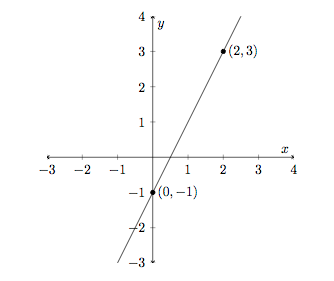Equation of a Line
Definition
A linear equation in two variables, often written as \( y = mx + b \), describes a line in the \( xy \)-plane. The line consists of all the solution pairs \( (x_0, y_0) \) that make the equation true.
For example, in the equation, , the line would pass through the points and because these ordered pairs are solutions to the equation, as is every other point on the line.
 A line through the points (0,-1) and (2,3)
A line through the points (0,-1) and (2,3)
The coefficient is the slope of the graph, and the constant is the -intercept.
The slope of a graph is the ratio between the rate of change of and the rate of change of , so for two points on a graph and , slope between them is:
Technique
What is the -intercept of the line described by ?
If , then , and so , which means the -intercept is .
What is in the point , if it falls on the line through the points and ?
The slope of the line is , so for all and on the graph. This means we can take one of the given points and substitute in its values to find .
Therefore, , and the equation of the line is . This means the point satisfies the equation . Thus, .
Applications and Extensions
The intersection of the line with the line through the points , , is a point . Find the sum of and .
First, we need to find the equation of the line through and . Since , the slope of the line must be 11. Further, since , the -intercept is .
Thus, our two equations are:
To find the point of intersection , we solve the system of equations above by equating the two 's.
Therefore, , and placing into either of the equations for gives us as the point of intersection. The answer, then, is .
Easy Math Editor
This discussion board is a place to discuss our Daily Challenges and the math and science related to those challenges. Explanations are more than just a solution — they should explain the steps and thinking strategies that you used to obtain the solution. Comments should further the discussion of math and science.
When posting on Brilliant:
*italics*or_italics_**bold**or__bold__paragraph 1
paragraph 2
[example link](https://brilliant.org)> This is a quote# I indented these lines # 4 spaces, and now they show # up as a code block. print "hello world"\(...\)or\[...\]to ensure proper formatting.2 \times 32^{34}a_{i-1}\frac{2}{3}\sqrt{2}\sum_{i=1}^3\sin \theta\boxed{123}Comments
I keep wondering at times, why is slope m=x2−x1y2−y1 and not m=y2−y1x2−x1 ? Both of them give same kind of information about the slope, one indicates the change in y per change in x and the other indicates the change in x per change in y. Is it just convention or is there some other reason to it?
Log in to reply
well since m=tanx, its very obvious that m=tanx=x2−x1y2−y1. Stay in this pattern is also very good because in higher grades we may need to solve like "What is the equation of the line which is perpendicular with line 5x+2=0 and pass through the point (7,0)?". Keep it m=tanx rather than cotx is more simple.
Or another way to explain is as a function f(x), x is the one who "change" and y is the one who "change because x changed". Then as m explains the different rate of change of y against x, then m=ΔxΔy=x2−x1y2−y1.
Log in to reply
Got it. Thanks.
What does line1 or line2 represent in three dimensional space?
Log in to reply
They represent two lines, since you can write them as: 0z+y=10x1+50z+y=11x2−2.